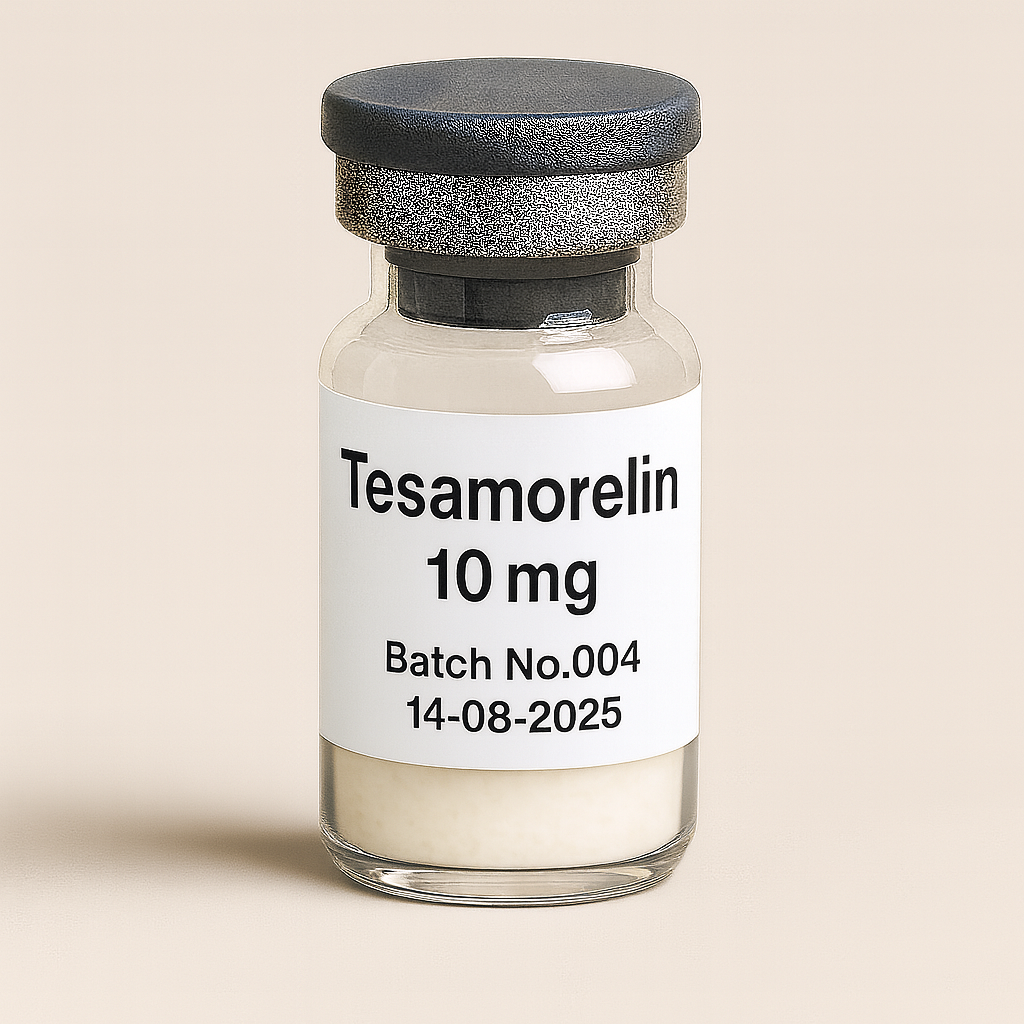O
Olivier livraison Rapide et soignée, support efficace !

Tesamorelin 10mg vial
Vyzvednutí není momentálně k dispozici
Tesamorelin binds GHRH receptors (GHRHR) on pituitary somatotrophs → Gs–cAMP–PKA–CREB signaling → GH pulse generation. Peripheral GH activates GHR–JAK2–STAT5 in liver and adipose, boosting IGF-1 and lipid-flux enzymes; somatostatin and IGF-1 provide negative feedback that preserves physiologic rhythms.
| Pathway | Functional outcome | Context |
|---|---|---|
| JAK2–STAT5 (GH) | ↑ IGF-1, ↑ hormone-sensitive lipase, ↓ de novo lipogenesis | Liver, adipose |
| PI3K–Akt–mTOR (IGF-1) | ↑ protein synthesis, ↑ fat-free mass | Skeletal muscle |
| AMPK/PPAR cross-talk | ↓ hepatic steatosis, improved VLDL handling | Liver |
| CNS neuroendocrine axes | Modulates sleep–metabolism–cognition via GH/IGF-1 | Hypothalamus/hippocampus |
Absorption: Rapid after SC injection; Tmax ~1 h.
Half-life (parent): ~1–2 h; pharmacodynamic effects persist via induced GH pulses and IGF-1 (24–48 h).
Distribution: Primary site of action is pituitary; systemic effects mediated by GH/IGF-1; minimal direct BBB penetration.
Clearance: Peptidase degradation; no known CYP interactions.
Dosing: Daily SC abdomen; rotate sites. EGRIFTA SV 2 mg vs EGRIFTA WR 1.28 mg—not interchangeable. FDA Prescribing Information
Multiple RCTs demonstrate clinically meaningful VAT loss, triglyceride reduction, and improved adipokines over 26–52 weeks, with VAT rebound off-drug and re-response upon re-treatment. NEJM; AIDS
12-month randomized data show reduced hepatic fat and lower fibrosis-progression risk; mechanisms likely include GH-dependent lipid flux and IGF-1 anti-fibrotic signaling. Lancet HIV; Hepatology Communications
A 20-week placebo-controlled trial in healthy older adults and those with MCI reported improved executive function and memory with tesamorelin-class GHRH analog therapy, correlating with IGF-1 increases. Archives of Neurology; JAMA Neurology
VAT responders show higher HDL, lower TG, and reduced inflammatory markers; risk modeling suggests favorable shifts in 10-year ASCVD risk. JCEM; Journal of Clinical Lipidology
DXA/CT sub-studies indicate preferential visceral-fat loss with maintenance or slight gain of lean mass and improved abdominal comfort/mobility. Obesity; AIDS
| Field | Rationale | Current status |
|---|---|---|
| HIV-NAFLD/MASH | VAT–liver axis; anti-steatotic/anti-fibrotic signals | Phase 2–3 translational work; label not expanded |
| Sarcopenic obesity | IGF-1–mediated anabolism with selective VAT loss | Early feasibility; no pivotal trials |
| Cognitive aging/MCI | GHRH→GH→IGF-1 neurotrophic pathways | Small RCT signal; larger trials needed |
| NAFLD without HIV | GH-deficiency phenotype in NAFLD | Pilot studies proposed |
Common: Injection-site reactions, edema, arthralgia/myalgia, paresthesia/carpal-tunnel-like symptoms (fluid retention).
Endocrine: IGF-1 elevation—monitor; glucose intolerance can emerge (check FPG/HbA1c; adjust antidiabetics).
Contraindications: Pregnancy, active malignancy, hypersensitivity (e.g., mannitol).
Oncology: Theoretical IGF-1-driven mitogenic risk; discontinue if malignancy occurs.
Ophthalmic/OSA: Fluid shifts may unmask/worsen retinopathy or sleep apnea.
Comparative safety matrix
| Concern | Tesamorelin (GHRH analog) | Somatropin (GH) |
|---|---|---|
| GH dynamics | Physiologic pulses via pituitary | Non-physiologic exogenous exposure |
| IGF-1 control | Feedback-limited | Directly dose-driven |
| Edema/arthralgia | Moderate, dose-dependent | Moderate–higher at equipotent IGF-1 |
| Glucose impact | Neutral → mild worsening (monitor) | Similar or slightly worse |
| Evidence for VAT | Robust RCTs in HIV lipodystrophy | Mixed in non-GHD adults |
Approved use: Reduction of excess abdominal fat in HIV-associated lipodystrophy.
Formulations (US): EGRIFTA SV 2 mg and EGRIFTA WR 1.28 mg once daily SC; not interchangeable.
Limitations of use: Not indicated for general weight loss; continue therapy only if VAT reduction is documented. FDA Prescribing Information
Metabolic phenotyping: Trials in HIV-NAFLD/MASH and sarcopenic obesity with imaging/biopsy endpoints.
Combination therapy: Pairing with GLP-1/GIP agonists or SGLT2 inhibitors to amplify hepatic and cardiometabolic outcomes while managing glycaemia.
Precision dosing: IGF-1 SDS-guided titration to balance efficacy and safety.
Formulation science: Long-acting depot or alternative delivery (e.g., transdermal, intranasal) to improve adherence.
Falutz J. et al. Randomized trials of tesamorelin in HIV lipodystrophy—VAT reduction and metabolic effects. New England Journal of Medicine; AIDS.
Stanley T.L. et al. Tesamorelin for HIV-associated NAFLD—reduced liver fat and fibrosis-progression risk. Lancet HIV; Hepatology Communications.
Engelson E.S. et al. Body-image and QoL outcomes with tesamorelin. HIV Medicine; AIDS Care.
Johnen H. et al. Adipokines, triglycerides, and inflammatory markers in VAT responders. Journal of Clinical Endocrinology & Metabolism.
Baker L.D. et al. GHRH analog (tesamorelin) improves cognition in older adults with/without MCI. Archives of Neurology; JAMA Neurology.
Grunfeld C. et al. Glycaemic safety and IGF-1 monitoring across tesamorelin RCTs. Diabetes Care; AIDS.
Theratechnologies. EGRIFTA SV/WR Prescribing Information—indication, dosing, contraindications, monitoring.